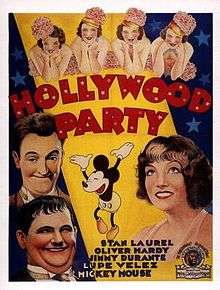Hollywood Party (1934 film)
| Hollywood Party | |
|---|---|
 theatrical poster | |
| Produced by |
|
| Written by | |
| Starring |
|
| Music by | |
| Edited by | George Boemler |
Production company | |
| Distributed by | Loew's Inc. |
Release dates |
|
Running time |
75 minutes (original) 68 minutes (existing) |
| Country | United States |
| Language | English |
Hollywood Party, also known under its working title of Hollywood Revue of 1933 and Star Spangled Banquet,[1][2] is a 1934 American Pre-Code musical film starring Laurel and Hardy, Jimmy Durante, Lupe Vélez and Mickey Mouse (voiced by an uncredited Walt Disney). It was distributed by Metro-Goldwyn-Mayer. The film has several disconnected sequences that have little connection with each other. Each sequence featured a different star with a separate scriptwriter and director assigned.
Plot

Jungle movie star "Schnarzan" (Durante), a character in parody of Tarzan, is advised by his manager he needs new lions for his pictures, as his old ones are "worn out". At a wild Hollywood party with many varied guests, including a "lion provider", hilarity ensues. After it all gets out of hand, Schnarzan awakens to find he is just plain old Durante, who had a strange dream.[3]
Cast
- Stan Laurel as Stan
- Oliver Hardy as Ollie
- Jimmy Durante as Durante / Schnarzan
- Lupe Velez as The Jaguar Woman / Jane in Schnarzan Sequence
- Jack Pearl as Baron Munchausen
- Polly Moran as Henrietta Clemp
- Charles Butterworth as Harvey Clemp
- Eddie Quillan as Bob Benson
- June Clyde as Linda Clemp
- George Givot as Liondora, aka Grand Royal Duke
- Richard Carle as Knapp
- Robert Young as Radio Announcer
- Walt Disney as Mickey Mouse
- The Three Stooges as The Three Stooges
- Jeanne Olsen as Mrs. Jimmy Durante (was married to Durante)
Production background
During production the film was known as Star Spangled Banquet and the Hollywood Revue of 1933.[1] Although Hollywood Party has no director credited, it has been asserted that Allan Dwan, Edmund Goulding, Russell Mack, Charles Reisner, Roy Rowland and Sam Wood directed various scenes with the overwhelming majority directed by Richard Boleslavsky.[4] George Stevens directed the Laurel and Hardy sequence[4] and Dave Gould directed the "Feelin' High" dance number with choreography by Georgie Hale. Seymour Felix and Eddie Prinz directed final reshoots.[5][6] Around the MGM backlot, the choreographers of the dance sequences were competing with those staging the MGM film Dancing Lady, vying to see who could create the most elaborate dance number.[7]
The film had many sequences cut or reshot after several references proved too esoteric for foreign audiences. A sequence that had featured Thelma Todd (impersonating Mae West), Lupe Velez, Jimmy Durante and Zasu Pitts playing bridge was deleted after it was lost on British viewers not yet familiar with the game.[6] Further episodes that featured actors Herman Bing, Johnny Weissmuller and Max Baer were cut from the film. As a result, surviving prints run approximately 68 minutes, but the original run time was 75 minutes. Famed songwriters Rodgers and Hart contributed most of the music.[4] Gus Kahn wrote "Moonlight Serenade" for the 1933 Busby Berkeley film Footlight Parade. However, when that song was cut from the Warner Brothers picture, it was placed a year later in Hollywood Party and sung by Eddie Quillan.[8]
The film was not a financial or critical success. It was considered too avant garde to appeal to a general audience. It remains significant today for its 31 stars, including Laurel and Hardy, radio celebrity Jack Pearl, The Three Stooges (in their final appearance for MGM), and Mickey Mouse. The Three Stooges routine was written by Arthur Kober.[9] The Mickey Mouse sequence introduces a Technicolor cartoon, "The Hot Choc-late Soldiers", created by Walt Disney with music by Nacio Herb Brown, and lyrics by Arthur Freed.
Reception
Critical reception for Hollywood Party upon its original release was largely negative.[2] Multiple exhibitors wrote in to the Motion Picture Herald to express their disgust with the film and one theater manager from Kentucky called it "One of the poorest excuses for a picture we have ever played".[10] The New York Times wrote that it "may have been very funny while it was being made, but as it comes to the screen it is not a little disappointing".[11]
See also
References
- 1 2 Variety, March 13, 1934.
- 1 2 Kaufman, J.B. (June 1993). "Before Snow White". Film History. 5 (2): 164–172. JSTOR 27670718.
- ↑ http://www.tcm.com/tcmdb/title/210/Hollywood-Party/
- 1 2 3 Variety, March 29, 1934
- ↑ Variety, November 18, 1933
- 1 2 Variety, February 22, 1934
- ↑ Variety, October 31, 1933
- ↑ Variety, August 22, 1933
- ↑ Variety, October 12, 1933
- ↑ Jenkins, Henry (1992). What Made Pistachio Nuts?: Early Sound Comedy and the Vaudeville Aesthetic. Columbia University Press. pp. 110–132. ISBN 9780231078559. Retrieved 4 June 2015.
- ↑ "Hollywood Party (1934)". The New York Times. May 26, 1934. Retrieved June 4, 2015.
External links
- Hollywood Party at the Internet Movie Database
- Theatrical trailer for Hollywood Party on YouTube
- "Hot Choc-late Soldiers" on YouTube